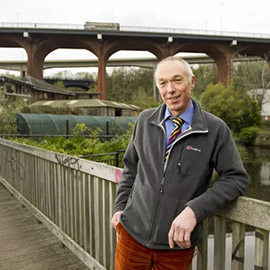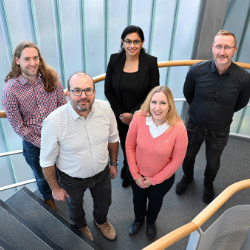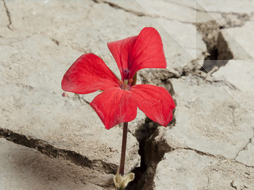-
Study
-
Quick Links
- Open Days & Events
- Real-World Learning
- Unlock Your Potential
- Tuition Fees, Funding & Scholarships
- Real World Learning
-
Undergraduate
- Application Guides
- UCAS Exhibitions
- Extended Degrees
- School & College Outreach
- Information for Parents
-
Postgraduate
- Application Guide
- Postgraduate Research Degrees
- Flexible Learning
- Change Direction
- Register your Interest
-
Student Life
- Students' Union
- The Hub - Student Blog
- Accommodation
- Northumbria Sport
- Support for Students
-
Learning Experience
- Real-World Learning
- Research-enriched learning
- Graduate Futures
- The Business Clinic
- Study Abroad
-
-
International
International
Northumbria’s global footprint touches every continent across the world, through our global partnerships across 17 institutions in 10 countries, to our 277,000 strong alumni community and 150 recruitment partners – we prepare our students for the challenges of tomorrow. Discover more about how to join Northumbria’s global family or our partnerships.
View our Global Footprint-
Quick Links
- Course Search
- Undergraduate Study
- Postgraduate Study
- Information for Parents
- London Campus
- Northumbria Pathway
- Cost of Living
- Sign up for Information
-
International Students
- Information for International Students
- Northumbria and your Country
- International Events
- Application Guide
- Entry Requirements and Education Country Agents
- Global Offices and Regional Teams
- English Requirements
- English Language Centre
- International student support
- Cost of Living
-
International Fees and Funding
- International Undergraduate Fees
- International Undergraduate Funding
- International Masters Fees
- International Masters Funding
- International Postgraduate Research Fees
- International Postgraduate Research Funding
- Useful Financial Information
-
International Partners
- Agent and Representatives Network
- Global Partnerships
- Global Community
-
International Mobility
- Study Abroad
- Information for Incoming Exchange Students
-
-
Business
Business
The world is changing faster than ever before. The future is there to be won by organisations who find ways to turn today's possibilities into tomorrows competitive edge. In a connected world, collaboration can be the key to success.
More on our Business Services-
Business Quick Links
- Contact Us
- Business Events
- Research and Consultancy
- Education and Training
- Workforce Development Courses
- Join our mailing list
-
Education and Training
- Higher and Degree Apprenticeships
- Continuing Professional Development
- Apprenticeship Fees & Funding
- Apprenticeship FAQs
- How to Develop an Apprentice
- Apprenticeship Vacancies
- Enquire Now
-
Research and Consultancy
- Space
- Energy
- AI and Tech
- CHASE: Centre for Health and Social Equity
- NESST
-
-
Research
Research
Northumbria is a research-rich, business-focused, professional university with a global reputation for academic quality. We conduct ground-breaking research that is responsive to the science & technology, health & well being, economic and social and arts & cultural needs for the communities
Discover more about our Research-
Quick Links
- Research Peaks of Excellence
- Academic Departments
- Research Staff
- Postgraduate Research Studentships
- Research Events
-
Research at Northumbria
- Interdisciplinary Research Themes
- Research Impact
- REF
- Partners and Collaborators
-
Support for Researchers
- Research and Innovation Services Staff
- Researcher Development and Training
- Ethics, Integrity, and Trusted Research
- University Library
- Vice Chancellors Fellows
-
Research Degrees
- Postgraduate Research Overview
- Doctoral Training Partnerships and Centres
- Academic Departments
-
Research Culture
- Research Culture
- Research Culture Action Plan
- Concordats and Commitments
-
-
About Us
-
About Northumbria
- Our Strategy
- Our Staff
- Our Schools
- Place and Partnerships
- Leadership & Governance
- University Services
- Northumbria History
- Contact us
- Online Shop
-
-
Alumni
Alumni
Northumbria University is renowned for the calibre of its business-ready graduates. Our alumni network has over 253,000 graduates based in 178 countries worldwide in a range of sectors, our alumni are making a real impact on the world.
Our Alumni - Work For Us
One of the key topics of discussion at the COP26 climate change summit is on how we can work with nature to improve our responses to the climate emergency. Government representatives, experts and negotiators are debating ways to ensure that nature and sustainable land use are part of global action on climate change and a clean, green recovery.
As a Professor in Environmental Geography at Northumbria University, Alister Scott is one of the UK’s leading experts with research focused on mainstreaming nature in policy and decision making. He has just completed three years working as a Natural Environment Research Council Fellow.
As part of our coverage of climate related research in Northumbria University, we asked Professor Scott to share his views on the six lessons that governments and decision makers can take from his research.

He explains: "I have spent the last three years working to improve how nature is mainstreamed in policy and decision making with a range of public, voluntary and private sector agencies and I have captured six key lessons as opportunities that should be applied in the COP26 discussions.
"However, perhaps the underlying context also needs reinforcing concerning the need for everyone to “wake up” and understand the need for URGENT ACTION now and move away from ambition, aspiration and greenwash.
Lesson 1:
The cost of ignoring the climate and nature emergencies is higher if you delay action now
Many counter narratives to urgent climate change action explain how the necessary changes involved in investing in nature or net zero are costly, impacting on profits or viability. This traditional approach to cost benefit analysis is short term in focus. It does not include the costs from flooding, wildfires, pollution, hospitalisation, illness, disease that are increasing at an alarming rate. So, for a volume house builder it makes sense to build as many houses as cheaply as possible as they are not responsible for extreme weather events down the line. If the full cost cycle was included in the planning stage it would make sense to build new houses with greywater systems and sustainable drainage for water management, as well as green spaces to help with air quality and wellbeing. The challenge is: who pays? Adopting more holistic principles as recognised by the Building with Nature accreditation or NATURE tool assessments incentivises developers and landowners to pursue multiple benefits for nature and society, but in so doing also adds value to properties and developments. A potential win-win. However, such incentives do not work well in isolation. They need also to be backed up by stronger planning regulation and policy to make sure that quality developments and interventions are undertaken in the right place. This also addresses critics of natural capital value and biodiversity and carbon offsetting markets as these interventions are measures of last resort if the mitigation hierarchy – avoid, minimize, restore and offset – is properly enforced.
Lesson 2:
We need to avoid the obsession with metrics of quantity
In my work I often see ambitious targets that all too easily become the metrics for success. Such as building 300,000 houses or planting 11 million trees. This is all fine and good but says nothing about the quality of homes that are built or whether the trees planted are managed and survive. We are starting to live in a tick box culture where we tend to value what we can easily quantify and measure, rather than measure what we most value. We need better metrics of quantity and quality. It is here that my work with Building with Nature offers some important insights in using qualitative criteria from which the quality of planned developments before and after construction are assessed, helping developers and planners understand what good green infrastructure looks like.
Lesson 3:
The climate, biodiversity, health and wellbeing and economic emergencies are all interlinked
Currently we collect evidence to diagnose and treat issues in separate silos without recognising their wider connections. Here nature delivers multiple benefits across climate, biodiversity, health and economic emergencies. But policy makers don’t work at the interfaces. There is a danger that COP26 is seen as the preserve of climate change; COP15 is seen for biodiversity and the G7 for economic challenges. From an English government perspective, how many environmental projects are explicitly working at the intersection and crossing government departments? In my view not enough and this is leading to a policy void and disintegrated policy. In making connections between these emergencies we also need to recognise that societal changes will impact the poor and vulnerable the most, which should put equity and social justice considerations at the heart of policy responses, not an afterthought. Here the Marmot review 10 years on sets the policy challenge.
Lesson 4:
We need better upfront collaboration with all relevant stakeholders including local communities to codesign better solutions and actions
Most people agree that engagement is a good thing to do and, indeed, there are statutory requirements for this. But often public engagement is seen as a burden that takes too long and slows down a given policy, plan or project. Hence, consultation can, all too easily, become tokenistic – with early input from the usual and influential suspects and consultation through quick and cheap web-based approaches. But proper engagement involves a co-design process with both usual and unusual suspects involved from the outset. It should be a conversation rather than a one-off event. Crucially, it is about realising who needs to be involved around the table to start to understand the problems and identify solutions. The innovative work of Newcastle City Futures signposts how a managed process of public engagement can lead to highly successful outcomes and projects. Equally more novel forms of engagement can lead to better insights, such as through games-based format.
Lesson 5:
We need to focus on delivery and evaluation rather than producing more and more strategy
Throughout my Fellowship I have attended a groundhog day of conference events on green infrastructure and climate change which seem to be fixed on providing evidence of the scale of the problem and challenge rather than on the delivery and evaluation phases to improve mainstreaming pathways. By focusing more on delivery we can work back to learn what has worked well – or indeed not worked well – to improve policy. Furthermore, we need to address the policy-delivery gap; there is never any shortage of strategy and plans, but there is rarely enough resource to actually deliver. Those involved in delivery must also be involved in the strategy. This is a key finding from my strategic planning for nature report.
Lesson 6:
Framing the climate change emergency positively is crucial
The words we use to frame the climate emergency are important. People naturally respond better to a positive opportunity rather than being scared by scientifically accurate doomsday narratives. Our planet and nature are in crisis for sure but the way we communicate this and translate the science to different audiences matters in terms of influencing their behaviours. Words matter and the rather obscure environmental vocabulary (e.g. ecosystem services, natural capital, green infrastructure, ecological networks, biodiversity), needs translation. As each new term has been introduced there has been little attention on trying to understand how they interrelate. They all feature in the climate change narrative, but the narrative fails to explain how they collectively contribute. There is a further problem in that many narratives see nature-based solutions as good and built development as somehow bad. A recent paper on integrating smart and biophilic narratives highlights the importance of silver, green and blue infrastructure working together in creating better quality developments. The underlying message is still clear; nature is more than something nice to have. It is essential critical infrastructure for our cities and countryside, and it is an integral part of the business case for nature.
These six lessons are not mutually exclusive. It seems to me that if we try to build these into our governance frameworks and consequential policy and practice responses for COP26 we might achieve more joined-up outcomes.
To find out more about Northumbria University's research and expertise in climate change, visit www.northumbria.ac.uk/livesustainably
News
- Venice Biennale Fellowship
- First cohort of Civil Engineering Degree Apprentices graduate from Northumbria
- Northumbria expands results day support for students
- Northumbria academic recognised in the British Forces in Business Awards 2025
- £1.2m grant extends research into the benefits of breast milk for premature babies
- Northumbria graduate entrepreneur takes the AI industry by storm
- Study identifies attitudes towards personal data processing for national security
- Lifetime Brands brings student design concept to life
- New study reveals Arabia’s ‘green past’ over the last 8 million years
- How evaluation can reform health and social care services
- Researchers embark on a project to further explore the experiences of children from military families
- Northumbria University's pioneering event series returns with insights on experiential and simulated learning
- Support for doctoral students to explore the experiences of women who have been in prison
- Funding boost to transform breastfeeding education and practice
- A new brand of coffee culture takes hold in the North East
- BBRSC awards £6m of funding for North East Bioscience Doctoral Students
- £3m funding to evaluate health and social care improvements
- Balfour Beatty apprentices graduate from Northumbria University
- Long COVID research team wins global award
- Northumbria researchers lead discussions at NIHR event on multiple and complex needs
- Healthcare training facility opens to support delivery of new T-level course
- Young people praise Northumbria University for delivery of HAF Plus pilot
- Nursing academics co-produce new play with Alphabetti Theatre
- Research project to explore the experiences of young people from military families
- Academy of Social Sciences welcomes two Northumbria Professors to its Fellowship
- Northumbria University set to host the Royal College of Nursings International Nursing Research Conference 2024
- 2.5m Award Funds Project To Encourage More People Into Health Research Careers
- Advice available for students ahead of A-level results day
- Teaching excellence recognised with two national awards
- Northumbria law student crowned first Apprentice of the Year for the region
- Northumbria University launches summer activities to support delivery of Holiday Activities and Food programme
- UK health leader receives honorary degree from Northumbria University
- Use of AI in diabetes education achieves national recognition
- Research animation explores first-hand experiences of receiving online support for eating disorders
- Careers event supports graduate employment opportunities
- Northumbria University announces £50m space skills, research and development centre set to transform the UK space industry
- The American Academy of Nursing honours Northumbria Professor with fellowship
- New report calls for more support for schools to improve health and wellbeing in children and young people
- AI experts explore the ethical use of video technology to support patients at risk of falls
- British Council Fellows selected from Northumbria University for Venice Biennale
- Prestigious nomination for Northumbria cyber security students
- Aspiring Architect wins prestigious industry awards
- Lottery funding announced to support mental health through creative education
- Early intervention can reduce food insecurity among military veterans
- Researching ethical review to support Responsible AI in Policing
- Northumbria named Best Design School at showcase New York Show
- North East universities working together
- Polar ice sheet melting records have toppled during the past decade
- Beyond Sustainability
- Brewing success: research reveals pandemic key learnings for future growth in craft beer industry
- City's universities among UK best
- Famous faces prepare to take to the stage to bring a research-based performance to life
- Insights into British and other immigrant sailors in the US Navy
- International appointment for law academic
- Lockdown hobby inspires award-winning business launch for Northumbria student
- Lasting tribute to Newcastle’s original feminist
- Outstanding service of Northumbria Professor recognised with international award
- Northumbria academics support teenagers to take the lead in wellbeing research
- Northumbria University becomes UK's first home of world-leading spectrometer
- Northumbria's Vice-Chancellor and Chief Executive to step down
- Out of this world experience for budding space scientists
- Northumbria engineering graduate named as one of the top 50 women in the industry
- Northumbria University signs up to sustainable fashion pledge
- Northumbria demonstrates commitment to mental health by joining Mental Health Charter Programme
- Virtual reality tool that helps people to assess household carbon emissions to go on display at COP26
- EXPERT COMMENT: Why thieves using e-scooters are targeting farms to steal £3,000 quad bikes, and what farmers can do to prevent it
- Exhibition of lecturer’s woodwork will help visitors reimagine Roman life along Hadrian’s Wall
- Students reimagine food economy at international Biodesign Challenge Summit
- Northumbria storms Blackboard Catalyst Awards
- Breaking news: Northumbria’s Spring/Summer Newspaper is here!
- UK’s first ever nursing degree apprentices graduate and join the frontline
- Massive decrease in fruit and vegetable intake reported by children receiving free school meals following lockdown
- Northumbria awards honorary degrees at University’s latest congregations
Geography At Northumbria University Encompasses All Of Our Work In Physical And Human Geography, Environmental Science And Management, Health & Safety, And Disaster Management.
This is the place to find all the latest news releases, feature articles, expert comment, and video and audio clips from Northumbria University
Latest News and Features

Royal Honour as leading researcher awarded Polar Medal
Professor John Woodward has been awarded The Polar Medal in recognition of his outstanding…

Report calls on the UK banking industry to consider interventions that "design out" economic abuse
Researchers have published the findings of a ground-breaking study which brought together victim-survivors…
.png?modified=20251222122622)
Northumbria's ‘Banana Split: Unpeeling a New Energy Source’ project highly commended at prestigious Green Gown Awards
A Northumbria University research project has been highly commended at the 2025 Green Gown…

Northumbria ranked most sustainable university in the North East for fifth consecutive year
Northumbria University has been rated as ‘1st class’ for sustainability and is once again the…

Northumbria expert delivers training to help address victim-blaming language
A Northumbria University academic is leading pioneering training to support police forces across…

Northumbria University launches national AI challenge inviting young people to imagine a hopeful future
Northumbria University has launched the Hopeful Futures AI Challenge, a groundbreaking national…

Student volunteering partnership expands following five years of community impact
Following the success of a Law in the Community project, Northumbria University is expanding…

Funding awarded for innovative space technology projects
The North East Space Communications Accelerator (NESCA) has successfully awarded its first…
Upcoming events

Collaborating for Capability: Shaping the Future of Supply Chain Talent
City Campus East, Northumbria University CCE1-403
-

Archives to Action: Historical Evidence for Policy Reform
Virtual Workshop
-

Viruses of Microbes-UK (VoM-UK) Conference 2026
Northumbria University

Commercialising SHAPE Innovations and Impact
Northumbria University
-




